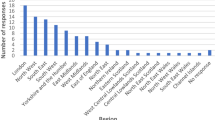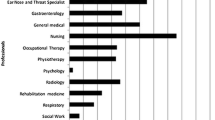Abstract
Whilst some research evidence supports the potential benefits of sensory enhancement strategies (SES) in dysphagia management, there is limited understanding of how SES are used in clinical services and the influencing drivers involved in selection during instrumental assessment. SES include modification of temperature, flavour, texture, chemesthetic qualities and bolus size of food/fluid. This study aimed to explore the use of SES within Australian Videofluoroscopic Swallow Study (VFSS) clinics providing adult services, via a qualitative methodology. Maximum variation sampling was used to select a cross section of speech-language pathologists (SLPs) with a range of experience working within 16 VFSS clinics across metropolitan and regional settings to participate in semi-structured, focus group or individual teleconference interviews. Content analysis of interview transcripts was conducted, with four themes emerging as influencing drivers of SES use, including: Patient factors influence SES use; Clinician factors influence SES use; Trials of SES require planning and organisation, and; Organisational barriers impact on SES use. These four themes were all connected through a single integrative theme: Extensive variations of SES procedures exist across clinical settings. Findings indicate that achieving alignment of clinical purpose and implementation of practices amongst VFSS clinicians will be complex given current diversity in SES use. Organisational issues and clinician training need to be addressed, and more research is needed to provide a stronger evidence base to inform clinical practice in this emerging area of dysphagia management.

Similar content being viewed by others
References
Butler S, Pelletier C, Steele C. In: Shaker R, Easterling C, Belafsky P, Postma G, editors. Manual of diagnostic and therapeutic techniques for disorders of deglutination. Berlin: Springer; 2013. doi:10.1007/978-1-4614-3779-6_16.
Logemann JA. Manual for the videofluoroscopic study of swallowing. 2nd ed. Austin: Pro Ed; 1993.
Leonard R, Kendall K, editors. Dysphagia assessment and treatment planning - a team approach. San Diego: Singular publishing group; 1997.
Jones B, editor. Normal and abnormal swallowing: imaging in diagnosis and therapy. 2nd ed. New York: Springer Verlag; 2003.
Logemann J, Pauloski B, Colangelo L, Lazarus C. Effects of a sour bolus on oropharyngeal swallowing measures in patients with neurogenic dysphagia. J Speech Hear Res. 1995;38:556–63.
Cola P, Gatto A, Da Silva R, Spadotto A, Schelp A, Henr M. The influence of sour taste and cold temperature in pharyngeal transit duration in pharyngeal transit duration in patients with stroke. Arc Gastroenterol. 2010;47:18–21.
Jennings K, Siroky D, Jackson C. Swallowing problems after excision of tumors of the skull base: diagnosis and management in 12 patients. Dysphagia. 1992;7:40–4.
Bülow M, Olsson R, Ekberg O. Videoradiographic analysis of how carbonated thin liquids and thickened liquids affect the physiology of swallowing in subjects with aspiration on thin liquids. Acta Radiol. 2003;44:366–72.
Sdravou K, Walshe M, Dagdilelis L. Effects of carbonated liquids on oropharyngeal swallowing measures in people with neurogenic dysphagia. Dysphagia. 2011;27:1–11.
Rofes L, Arreola V, Martin A, Clave P. Natural capsaicinoids improve swallow response in older patients with oropharyngeal dysphagia. Gut. 2013;62:1280–7.
Pauloski B, Logemann J, Rademaker A, Lundy D, Sullivan P, Newman L, Lazarus C, Bason M. Effects of enhanced bolus flavors on oropharyngeal swallow in patients treated for head and neck cancer. Head Neck. 2013;35:1124–31.
Martino R, Pron G, Diamant N. Oropharyngeal Dysphagia: surveying Practice Patterns of the Speech-Language Pathologist. Dysphagia. 2004;19:165–76.
Power M, Laasch H-U, Kasthuri R, Nicholson D, Hamdy S. Videofluoroscopic assessment of dysphagia: a questionnaire survey of protocols, roles and responsibilities of radiology and speech and language therapy personnel. Radiography. 2006;12:26–30.
Martin-Harris B, Jones B. The videofluorographic swallowing study. Phys Med Rehabil Clin N Am. 2008;19:769–85.
The Speech Pathology Association of Australia limited, Clinical Guideline—Videofluoroscopic swallow study. (2013). http://www.speechpathologyaustralia.org.au/library/Clinical_Guidelines Accessed 10 Jan 2016.
The Speech Pathology Association of Australia, Clinical Guideline–Dysphagia. (2012). http://www.speechpathologyaustralia.org.au/library/Clinical_Guidelines. Accessed 10 Jan 2016.
Sandelowski M. Whatever happened to qualitative description? Res Nurs Health. 2000;23:334–40.
Miles M, Huberman A. Qualitative data analysis- an expanded sourcebook. 2nd ed. London: Sage publications; 1994.
Robson C. Real world research – a resource for social scientists and practitioner-researchers. U.K.: Blackwell publishers Ltd; 1997.
Patton M. Qualitative evaluation and research methods. 3rd ed. California: Sage publication; 1990.
Graneheim U, Lundman B. Qualitative content analysis in nursing research: concepts, procedures and measures to achieve trustworthiness. Nurs Educ Today. 2004;24:105–12.
Saldana J. The coding manual of qualitative researchers. 2nd ed. London: Sage publications; 2013.
Tong A, Sainsbury P, Craig J. Consolidated criteria for reporting qualitative research (COREQ): a 32-item checklist for interviews and focus groups. Int J Qual Health Care. 2007;19:349–57.
Turkington L, Ward E, Farrell A. Carbonation as a sensory enhancement strategy: a narrative synthesis of existing evidence. Disabil Rehabil. 2016;. doi:10.1080/09638288.2016.1213894.
Steele C, Miller A. Sensory input pathways and mechanisms in swallowing: a review. Dysphagia. 2010;25:323–33.
Soklaridis S. The process of conducting qualitative grounded theory research for a doctoral thesis: experiences and reflections. Qual Rep. 2009;14:719–34.
Bryant K, Finnegan E, Berbaum K. VFS interjudge reliability using a free and directed search. Dysphagia. 2012;27:53–63. doi:10.1007/s00455-011-9337-1.
Guest G, Bunce A, Johnson L. How many interviews are enough? An experiment with data saturation and variability. Field Methods. 2006;18:59–82.
Acknowledgments
The authors would like to thank the valuable contribution provided by study participants who generously offered their time to complete the teleconference interviews and content checking as well as the Speech Pathology service, Royal Brisbane and Women’s Hospital, The Royal Brisbane and Women’s Hospital Foundation Trust and the University of Queensland for the provision of significant support to complete this study.
Author information
Authors and Affiliations
Corresponding author
Ethics declarations
Conflict of interest
The authors declare that they have no conflict of interest.
Appendix 1: Interview Guide–Core Questions
Appendix 1: Interview Guide–Core Questions
Tell me about compensatory techniques that you use in VFSS clinic
-
Potential Probes: Can you think of specific postural strategies/swallow maneuvers that you use?
-
When do you use these strategies?
-
How frequently do you use these strategies?
-
Can you give me an example?
-
-
1.
Tell me about any sensory enhancement strategies (SES) that you use in your clinic?
Potential Probes: Can you think of specific SES strategies (taste, temperature, carbonation)?
When do you use these strategies?
How frequently do you use these strategies?
Can you give me an example?
-
2.
Describe your SES preparation methods
Potential Probes: Do you follow set procedures when preparing SES?
Do you have recipes?
-
3.
What order do you trial SES in your clinic?
Potential Probe: Do you trial SES in a specific order? Why?
Are SES trialled in your clinic with reference to other compensatory strategies?
-
4.
Describe any positive outcomes you have encountered when using SES within VFSS?
Potential Probes: Can you give me an example?
What was the case?
What happened?
Who else was there?
What did you do?
-
5.
Now describe any challenges you have encountered when using SES within VFSS?
Potential Probes: Can you give me an example?
What was the case?
What happened?
Who else was there?
What did you do?
-
6.
Tell me about any contraindications you consider when using SES?
-
7.
Tell me about the particular clinical populations you will/will not trial SES?
Potential Probes: Why/why not?
-
8.
Describe the recommendations you make following SES testing within VFSS clinic?
Potential probes: Are results used to guide diet recommendations ?
Are results used to guide direct swallow stimulation trials ?
-
9.
Tell me how your clinical background and experience influences your use of SES in VFSS clinic? Do you have examples?
-
10.
Rounding up: This project attempts to identify key drivers which influence selection of SES within VFSS. Before we close is there anything else we have not discussed that could help me to understand the factors that influence your selection of SES in VFSS?
Rights and permissions
About this article
Cite this article
Turkington, L., Nund, R.L., Ward, E.C. et al. Exploring Current Sensory Enhancement Practices Within Videofluoroscopic Swallow Study (VFSS) Clinics. Dysphagia 32, 225–235 (2017). https://doi.org/10.1007/s00455-016-9747-1
Received:
Accepted:
Published:
Issue Date:
DOI: https://doi.org/10.1007/s00455-016-9747-1




